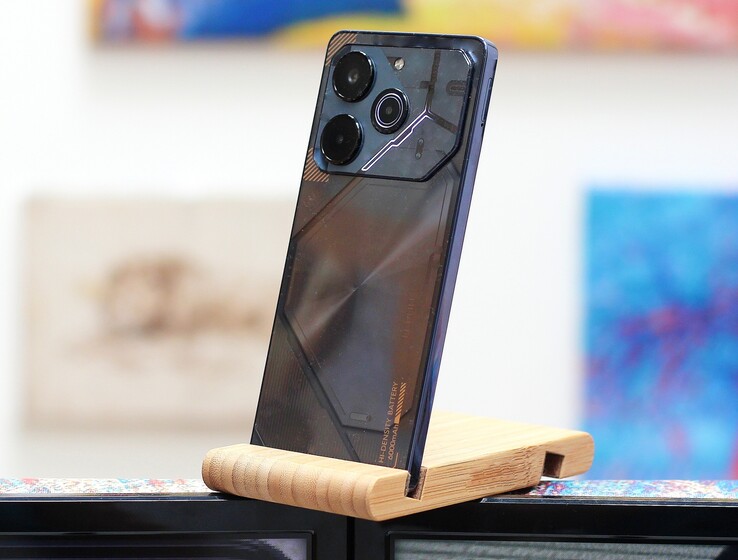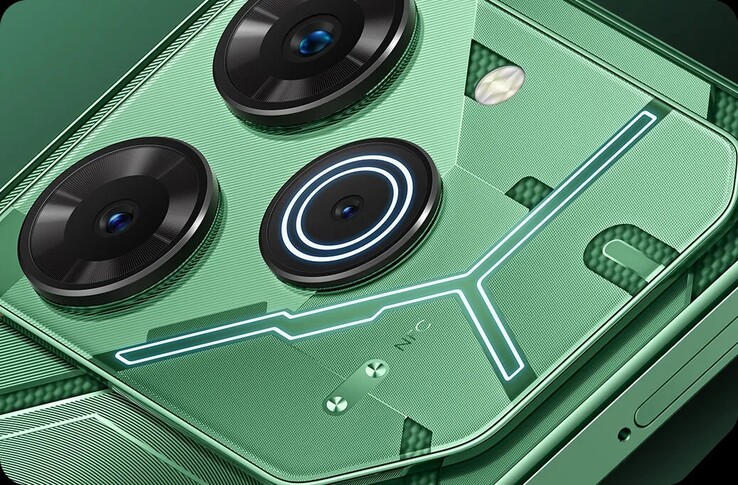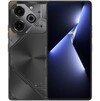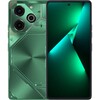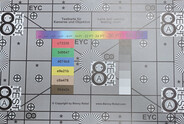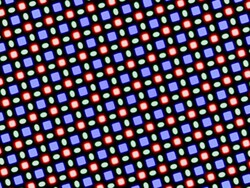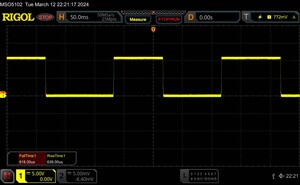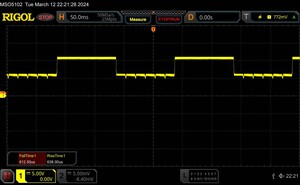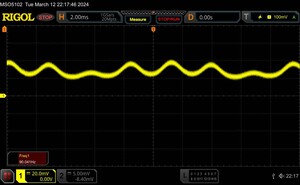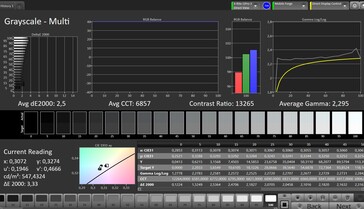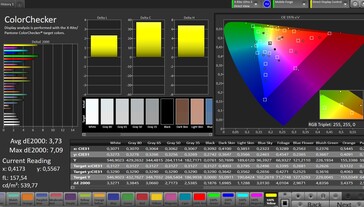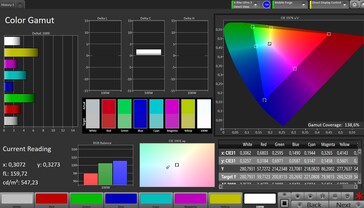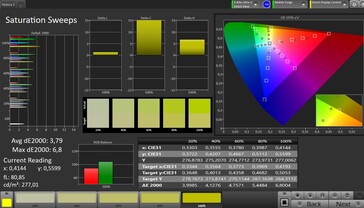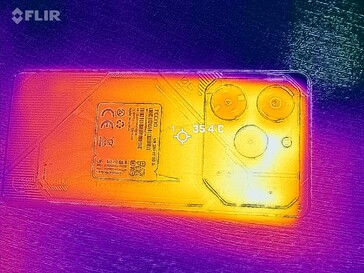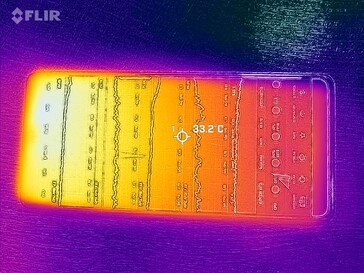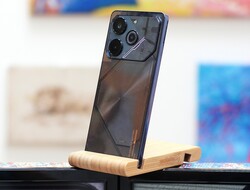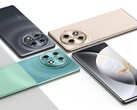Tecno Pova 6 Pro 5G smartphone review – Endurance artist with a light show
Possible competitors compared
Rating | Date | Model | Weight | Storage device | Size | Resolution | Price from |
|---|---|---|---|---|---|---|---|
| 81.4 % v7 (old) | 04 / 2024 | Tecno Pova 6 Pro Dimensity 6080, Mali-G57 MP2 | 195 g | 256 GB UFS 2.2 Flash | 6.78" | 2436x1080 | |
| 80.1 % v7 (old) | 03 / 2024 | Samsung Galaxy A15 5G Dimensity 6100+, Mali-G57 MP2 | 200 g | 128 GB UFS 2.2 Flash | 6.50" | 2340x1080 | |
| 78.3 % v7 (old) | 08 / 2023 | Nokia G42 SD 480+, Adreno 619 | 194 g | 128 GB UFS 2.2 Flash | 6.56" | 1612x720 | |
| 80.4 % v7 (old) | 08 / 2023 | Xiaomi Redmi Note 12S Helio G96, Mali-G57 MP2 | 176 g | 256 GB UFS 2.2 Flash | 6.43" | 2400x1080 |
Case and connectivity – Reminiscent of the brand Nothing
If you take a look at the Tecno Pova 6 Pro and are immediately reminded of the phones from the manufacturer Nothing, then you would be correct: The half transparent design, which at least pretends to show technical components and switches, along with the lighting effects on the back, are actually the trademarks of the Nothing Phone (1) and the Phone (2).
Tecno has also shown it can implement the idea well with its two different color variants on offer: Green and gray. In both cases, the mini LEDs for the light show are only installed into the large camera module, i.e. not across the entire back like on the Nothing phones.
The phone has a high-quality appearance but is susceptible to fingerprints due to its smooth back, and it creaks noticeably when pressed or twisted. The phone fits well in your hand and looks very modern on the front thanks to the narrow bezels around the screen. In terms of weight, it is in line with other phones in its price range, so it is neither too heavy nor too light. The case is protected against splashes of water and dust in accordance with IP53.
With 256 GB of mass storage and 12 GB RAM, the phone also offers a generous amount of memory, which is rarely found for this price: With the Galaxy A15 5G, for example, you have to make do with less mass storage and only 4 GB RAM.
In addition to NFC for mobile payment services, an infrared port is also available which lets you use the phone as a remote control for TVs or audio systems, for example. There is also a dedicated 3.5 mm audio port which prevents the USB-C port from being blocked by wired headphones.
You'll find two SIM slots if you open the drawer on the side of the smartphone. It doesn't support eSIMs. The microSD slot for storage expansion is a dedicated one, so you don't have to sacrifice a SIM slot if you want to insert a microSD card. The card reader worked comparatively quickly and achieved good read and write values in our tests using our Angelbird V60 reference card.
| SD Card Reader - average JPG Copy Test (av. of 3 runs) | |
| Samsung Galaxy A15 5G (Angelbird V60) | |
| Tecno Pova 6 Pro (Angelbird V60) | |
| Average of class Smartphone (5.72 - 58.9, n=68, last 2 years) | |
| Nokia G42 (Angelbird V60) | |
| Xiaomi Redmi Note 12S (Angelbird V60) | |
Cross Platform Disk Test (CPDT)
Communication, software and operation – Lots of 5G frequencies
WiFi 5 is the fastest Wi-Fi standard mastered by the smartphone. Its data rates in our test using the Asus ROG Rapture AXE11000 as a reference router were quite stable and in the usual range for this class, namely between around 280 and 350 MBit/s. This means that a home gigabit Internet connection cannot be fully taken advantage of, but a fast and stable connection is possible via WLAN nonetheless.
When it comes to the phone's cellular network, you can also make use of the latest 5G standard—this is even possible using both SIM cards at the same time. There are enough frequencies available for reliable network connections in Central Europe, which is where this test was carried out. If you are traveling further afield, you should check in advance: The Tecno Pova 6 Pro is not a world phone that can be used anywhere.
The manufacturer has pre-installed Android 14 onto the device, with the in-house HiOS interface placed on top. Visually, this is somewhat reminiscent of Xiaomi's operating system but at the same time, it hasn't changed stock Android all too much. A kind of dynamic island also opens around the front camera lens if required, displaying information about the device's charging status or notifications, for example.
At the time of testing, the latest security patches date from January 2024 and are therefore just within the acceptable 3-month period. Unfortunately, the manufacturer hasn't specified how long security updates are planned or how many operating system versions will be available for this phone.
A fingerprint sensor is installed behind the screen and it is positioned relatively low down, making it easy to reach even with small hands. It unlocks the system quickly and reliably once a fingerprint has been saved. The phone can often be unlocked even with wet fingers, even if it takes several attempts to do so from time to time. If you prefer to use facial recognition, this also works reliably in good lighting conditions or when using the screen as lighting.
| Networking | |
| iperf3 transmit AXE11000 | |
| Xiaomi Redmi Note 12S | |
| Nokia G42 | |
| Tecno Pova 6 Pro | |
| Samsung Galaxy A15 5G | |
| iperf3 receive AXE11000 | |
| Nokia G42 | |
| Xiaomi Redmi Note 12S | |
| Samsung Galaxy A15 5G | |
| Tecno Pova 6 Pro | |
Cameras – Disappointing main camera, but good selfies
Tecno has installed a 108-megapixel camera into the phone, thus making use of the maximum possibilities of the SoC's image processing chip. Normally, the camera uses pixel binning to bundle 9 pixels into one large pixel, resulting in a higher light yield but, of course, this only produces images with a resolution of 12 megapixels. This is completely sufficient for the vast majority of applications. The sensor's full resolution can also be used when selecting a special mode within the camera software.
Despite its efforts to capture more light, the phone only managed to achieve a mediocre level of brightness in our test images which we took on not entirely sunny days. The photo of our surroundings is also lacking in detailed sharpness, leaving some room for improvement. If the photos are not enlarged too much, you can take decent snapshots. In very low light with high contrasts, the dynamic range is very low in dark areas and even the bright candle was not adequately depicted.
The photo taken in our laboratory setup which mimics ideal lighting conditions is actually quite good, albeit somewhat over-illuminated in some areas. However, the image sharpness is quite good in this scenario. In very low light, the camera no longer recognizes any details.
You can record video in up to 1440p and at 30 fps, and 60 frames per second are also possible at 1080p. In this case, its picture quality is actually pretty decent—the autofocus reacts reasonably quickly and the brightness adjustment also works quite reliably after a minimal waiting time.
The second camera on the back is only a support lens for blur effects and cannot take its own photos.
Selfies can be taken on the front-facing camera which has a 32-megapixel resolution. It takes nice pictures in good light, which can also be enlarged without losing too much detail.
Image comparison
Choose a scene and navigate within the first image. One click changes the position on touchscreens. One click on the zoomed-in image opens the original in a new window. The first image shows the scaled photograph of the test device.
Main camera plantMain camera surroundingsMain camera low light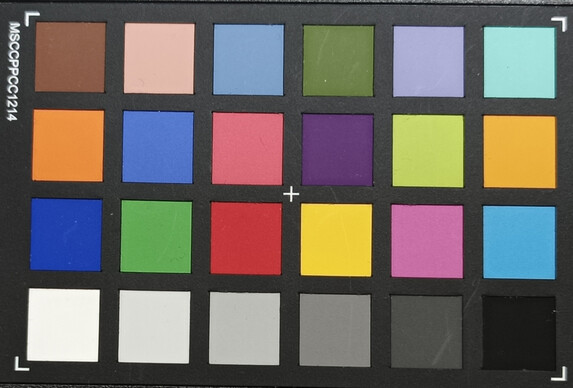
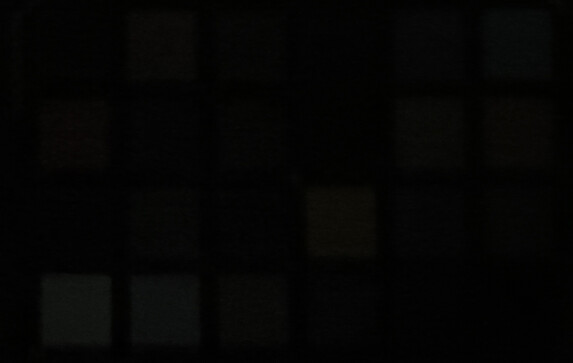
Display – Only bright when depicting small areas
The Pova 6 Pro's screen uses AMOLED technology and can display up to 120 images per second in a resolution of 2,436 x 1,080 pixels. Tecno attaches particular importance to the phone's high sampling rate of up to 1,500 Hz, with which the touchscreen responds to touches.
Our tests revealed a mixed picture in terms of brightness: Although small areas can get quite bright at over 1,000 cd/m², its brightness is limited to just under 550 cd/m² when the screen is completely white. This is still a sufficient value for indoor use, but similarly priced comparison phones often perform better outdoors.
We also noticed some flickering with a frequency of 90 Hz at the minimum brightness level. Sensitive users should therefore test the screen before buying, as they could experience some problems such as headaches or nausea.
In our measurements using the CalMAN software and a spectrophotometer, we noted a minimal blue tint and that very bright and vivid colors were displayed a little distorted. This means that the screen is not ideally calibrated for professional applications.
| |||||||||||||||||||||||||
Brightness Distribution: 96 %
Center on Battery: 549 cd/m²
Contrast: ∞:1 (Black: 0 cd/m²)
ΔE ColorChecker Calman: 3.73 | ∀{0.5-29.43 Ø4.77}
ΔE Greyscale Calman: 2.5 | ∀{0.09-98 Ø5}
138.6% sRGB (Calman 2D)
Gamma: 2.295
CCT: 6857 K
| Tecno Pova 6 Pro AMOLED, 2436x1080, 6.8" | Samsung Galaxy A15 5G AMOLED, 2340x1080, 6.5" | Nokia G42 IPS, 1612x720, 6.6" | Xiaomi Redmi Note 12S AMOLED, 2400x1080, 6.4" | |
|---|---|---|---|---|
| Response Times | -21% | -2283% | -104% | |
| Response Time Grey 50% / Grey 80% * (ms) | 1.2 | 1.6 ? -33% | 35.5 ? -2858% | 2.8 ? -133% |
| Response Time Black / White * (ms) | 1.2 | 1.3 ? -8% | 21.7 ? -1708% | 2.1 ? -75% |
| PWM Frequency (Hz) | 90 | 90 | 355.6 | |
| Screen | 30% | -45% | 36% | |
| Brightness middle (cd/m²) | 549 | 705 28% | 495 -10% | 627 14% |
| Brightness (cd/m²) | 548 | 701 28% | 452 -18% | 631 15% |
| Brightness Distribution (%) | 96 | 96 0% | 84 -12% | 97 1% |
| Black Level * (cd/m²) | 0.5 | |||
| Colorchecker dE 2000 * | 3.73 | 1.88 50% | 6.09 -63% | 1.15 69% |
| Colorchecker dE 2000 max. * | 7.09 | 4.57 36% | 9.35 -32% | 2.05 71% |
| Greyscale dE 2000 * | 2.5 | 1.5 40% | 5.8 -132% | 1.4 44% |
| Gamma | 2.295 96% | 2.116 104% | 2.325 95% | 2.284 96% |
| CCT | 6857 95% | 6501 100% | 8169 80% | 6347 102% |
| Contrast (:1) | 990 | |||
| Total Average (Program / Settings) | 5% /
18% | -1164% /
-604% | -34% /
1% |
* ... smaller is better
Display Response Times
| ↔ Response Time Black to White | ||
|---|---|---|
| 1.2 ms ... rise ↗ and fall ↘ combined | ↗ ms rise | |
| ↘ ms fall | ||
| The screen shows very fast response rates in our tests and should be very well suited for fast-paced gaming. In comparison, all tested devices range from 0.1 (minimum) to 240 (maximum) ms. » 5 % of all devices are better. This means that the measured response time is better than the average of all tested devices (20.2 ms). | ||
| ↔ Response Time 50% Grey to 80% Grey | ||
| 1.2 ms ... rise ↗ and fall ↘ combined | ↗ ms rise | |
| ↘ ms fall | ||
| The screen shows very fast response rates in our tests and should be very well suited for fast-paced gaming. In comparison, all tested devices range from 0.165 (minimum) to 636 (maximum) ms. » 5 % of all devices are better. This means that the measured response time is better than the average of all tested devices (31.6 ms). | ||
Screen Flickering / PWM (Pulse-Width Modulation)
| Screen flickering / PWM detected | 90 Hz | ||
The display backlight flickers at 90 Hz (worst case, e.g., utilizing PWM) . The frequency of 90 Hz is very low, so the flickering may cause eyestrain and headaches after extended use. In comparison: 53 % of all tested devices do not use PWM to dim the display. If PWM was detected, an average of 8084 (minimum: 5 - maximum: 343500) Hz was measured. | |||
Measurement series with fixed zoom level and different brightness settings
Performance, emissions and runtimes – Speedy storage
The phone uses the fairly new MediaTek Dimensity 6080 as an SoC, but it is not that new—it is actually a fairly exact copy of the Dimensity 810. Nevertheless, the Pova 6 Pro showed good performance values for its price range, with the comparison devices falling slightly behind in most benchmarks.
This usually ensures smooth system operation, but users who often use very complex apps will experience stutters and longer waiting times. Websites load reasonably quickly, but you have to wait for images from time to time. We really like the powerful UFS 2.2 data storage, which is supported by a fast controller. This means that loading times can be shortened and data transfers are faster.
The maximum amount that the case temperatures rise remains within limits under prolonged load: We measured a maximum of 40.5 °C. This is noticeable, but not problematic. Its performance doesn't suffer after prolonged load either; the 3DMark stress tests delivered stable results even after 20 runs.
The earpiece is used for sound output alongside a dedicated speaker on the bottom edge of the device. This gives the Tecno smartphone a balanced sound. Although its range is not sufficient for low mids and bass, the sound is pleasant and not too treble-heavy.
External speakers or headphones can be connected via the jack connection and Bluetooth. Various Bluetooth audio codecs are available for wireless transmission, including standards such as AAC and aptX, hi-res audio codecs such as LDAC and LHDC V3/V4 and less well-known alternatives such as Opus. So, the variety here is huge.
Tecno advertises the battery's high energy density and the smartphone is indeed relatively light considering its size and battery capacity consisting of 6,000 mAh. Its runtimes were impressive during the WLAN test: you can surf the web for 1,108 minutes or 18:28 hours at lower screen brightness levels. This clearly beat the comparison devices, resulting in the phone needing to be charged much less frequently.
If you do need to access a power outlet, it won't be for too long, as the Tecno Pova 6 Pro can be charged at a maximum of 70 watts. The system lets you choose between fast or gentle charging, and at maximum speed, the battery is fully charged again in less than an hour. External devices can be supplied with up to 10 watts via wired reverse charging thanks to the phone's large battery.
| Tecno Pova 6 Pro | Samsung Galaxy A15 5G | Nokia G42 | Xiaomi Redmi Note 12S | Average 256 GB UFS 2.2 Flash | Average of class Smartphone | |
|---|---|---|---|---|---|---|
| AndroBench 3-5 | -14% | -24% | -14% | 14% | 122% | |
| Sequential Read 256KB (MB/s) | 991.8 | 499.6 -50% | 492.5 -50% | 518.7 -48% | 903 ? -9% | 2235 ? 125% |
| Sequential Write 256KB (MB/s) | 515.3 | 498.1 -3% | 461.8 -10% | 492.3 -4% | 727 ? 41% | 1871 ? 263% |
| Random Read 4KB (MB/s) | 192.6 | 194 1% | 183.3 -5% | 211.9 10% | 226 ? 17% | 297 ? 54% |
| Random Write 4KB (MB/s) | 235.7 | 223.5 -5% | 161.1 -32% | 202.6 -14% | 247 ? 5% | 343 ? 46% |
Temperature
(±) The maximum temperature on the upper side is 40.5 °C / 105 F, compared to the average of 35.2 °C / 95 F, ranging from 21.9 to 247 °C for the class Smartphone.
(+) The bottom heats up to a maximum of 39.3 °C / 103 F, compared to the average of 34 °C / 93 F
(+) In idle usage, the average temperature for the upper side is 23.5 °C / 74 F, compared to the device average of 32.9 °C / 91 F.
3DMark Wild Life Stress Test
Speakers
Tecno Pova 6 Pro audio analysis
(±) | speaker loudness is average but good (79 dB)
Bass 100 - 315 Hz
(-) | nearly no bass - on average 30.5% lower than median
(±) | linearity of bass is average (10% delta to prev. frequency)
Mids 400 - 2000 Hz
(±) | higher mids - on average 5.9% higher than median
(±) | linearity of mids is average (8.9% delta to prev. frequency)
Highs 2 - 16 kHz
(+) | balanced highs - only 4.4% away from median
(+) | highs are linear (4.7% delta to prev. frequency)
Overall 100 - 16.000 Hz
(±) | linearity of overall sound is average (25.1% difference to median)
Compared to same class
» 61% of all tested devices in this class were better, 7% similar, 32% worse
» The best had a delta of 11%, average was 35%, worst was 134%
Compared to all devices tested
» 76% of all tested devices were better, 5% similar, 19% worse
» The best had a delta of 4%, average was 24%, worst was 134%
Xiaomi Redmi Note 12S audio analysis
(±) | speaker loudness is average but good (81.3 dB)
Bass 100 - 315 Hz
(-) | nearly no bass - on average 32.3% lower than median
(±) | linearity of bass is average (11.4% delta to prev. frequency)
Mids 400 - 2000 Hz
(+) | balanced mids - only 4.4% away from median
(+) | mids are linear (5.6% delta to prev. frequency)
Highs 2 - 16 kHz
(±) | higher highs - on average 5.3% higher than median
(+) | highs are linear (6.1% delta to prev. frequency)
Overall 100 - 16.000 Hz
(±) | linearity of overall sound is average (24.2% difference to median)
Compared to same class
» 56% of all tested devices in this class were better, 7% similar, 36% worse
» The best had a delta of 11%, average was 35%, worst was 134%
Compared to all devices tested
» 72% of all tested devices were better, 6% similar, 22% worse
» The best had a delta of 4%, average was 24%, worst was 134%
Runtimes
| Battery Runtime - WiFi Websurfing | |
| Average of class Smartphone (12.1 - 54.1, n=208, last 2 years) | |
| Tecno Pova 6 Pro | |
| Samsung Galaxy A15 5G | |
| Xiaomi Redmi Note 12S | |
| Nokia G42 | |
Pros
Cons
Verdict – A unique phone and a good total package
The Tecno Pova 6 Pro may still be quite an exotic find in Europe, but its extravagant design (clearly inspired by the Nothing phones) will certainly attract attention. It is sturdily built, offers plenty of storage and, above all, really good runtimes in everyday use.
With the keyword "Mini LED", Tecno could indeed gain the interest of some buyers. However, it should be noted that this is not a mini LED screen (as used on some modern laptops) but instead, the notification lights on the back. These are individually customizable and, if desired, provide a permanent good mood using party mode.
The phone's display, on the other hand, uses AMOLED technology and can get really bright in small areas, although it only achieves average values when depicting a full white screen. The device is therefore not quite as suitable for outdoor use and displaying HDR content as some of its competitors. We also noticed PWM flickering, so sensitive users should test the screen before buying.
The main camera doesn't take the best pictures, but the selfies using the front-facing camera are good. The stereo speakers are also impressive with a rounded sound. Small details such as reverse charging via a cable and an infrared sensor round off the phone's overall package.
While the Tecno Pova 6 Pro is a lesser-known mid-range phone in the West, it scores points with its modern design, long battery life and good performance.
The Nothing Phone (2) is significantly more expensive, but those who like the design of the Tecno Pova 6 Pro will find it to be a viable alternative. If you prefer something less eccentric but still with a good price-to-performance ratio, you could consider the Redmi Note 12S.
Price and availability
At the time of writing, the Tecno Pova 6 Pro is not yet available to buy in the United States.
You can find its predecessor, the Tecno Pova 5 Pro, on Amazon for US$109.99.
Tecno Pova 6 Pro
- 04/09/2024 v7 (old)
Florian Schmitt
Transparency
The selection of devices to be reviewed is made by our editorial team. The test sample was provided to the author as a loan by the manufacturer or retailer for the purpose of this review. The lender had no influence on this review, nor did the manufacturer receive a copy of this review before publication. There was no obligation to publish this review. As an independent media company, Notebookcheck is not subjected to the authority of manufacturers, retailers or publishers.
This is how Notebookcheck is testing
Every year, Notebookcheck independently reviews hundreds of laptops and smartphones using standardized procedures to ensure that all results are comparable. We have continuously developed our test methods for around 20 years and set industry standards in the process. In our test labs, high-quality measuring equipment is utilized by experienced technicians and editors. These tests involve a multi-stage validation process. Our complex rating system is based on hundreds of well-founded measurements and benchmarks, which maintains objectivity. Further information on our test methods can be found here.




